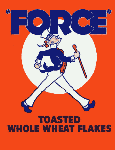
Force (cereal)
Encyclopedia

Sunny Jim
"Sunny Jim" is the name of two completely unconnected characters used in advertising and product branding: a cartoon character created to promote Force cereal, the first commercially successful wheat flake;...
, was the first commercially successful wheat flake cereal. Prior to this, the only successful wheat-based cereal products had been Shredded Wheat
Shredded Wheat
Shredded wheat is a breakfast cereal made from whole wheat. As of January 2010, it was available in three sizes: bite sized , miniature , and full size, which may be broken into small pieces before milk is added .Both sizes are available in a...
and the hot semolina cereal, Cream of Wheat
Cream of Wheat
Cream of Wheat is a porridge-type breakfast food invented in 1893 by wheat millers in Grand Forks, North Dakota. The cereal is currently manufactured and sold by B&G Foods. Until 2007, it was the Nabisco brand made by Kraft Foods. It is similar in texture to grits, but made with farina instead...
. The product was cheap to produce and kept well on store shelves.
The first advertising copy for the new product described the cereal as "The Food That is all Food", the advertising images showed rosy-cheeked children, and it was sold in a box decorated with images of muscular men wrestling with chains. Perhaps because it was not initially targeted at a well defined market, it did not sell well.
In late 1901 Minnie Maud Hanff, a freelance jingle writer, invented the character Jimmy Dumps, a morose character who on eating the cereal was transformed into Sunny Jim
Sunny Jim
"Sunny Jim" is the name of two completely unconnected characters used in advertising and product branding: a cartoon character created to promote Force cereal, the first commercially successful wheat flake;...
. Dorothy Ficken produced line drawings, and Hanff produced light hearted jingles describing Sunny Jim's transformation. The advertising appeared in magazines, on billboards, and on the sides of urban trolley cars from May 1902 through to the fall.
The campaign was wildly successful. Force was originally produced in a single plant in Buffalo, but by early 1904 the Canadian Grocer reported that there was one more Force food mill in Buffalo, a third mill in Chicago and one in Hamilton, Ontario
Hamilton, Ontario
Hamilton is a port city in the Canadian province of Ontario. Conceived by George Hamilton when he purchased the Durand farm shortly after the War of 1812, Hamilton has become the centre of a densely populated and industrialized region at the west end of Lake Ontario known as the Golden Horseshoe...
, producing a total of 360,000 packages per day.
Ellsworth overextended and lost control of his companies in 1907. After that the Force cereal changed ownership frequently.
In 1903 a British subsidiary of the Force Food Company was formed to import the cereal to Europe. A slightly modified version of Sunny Jim and his jingles caught the fancy of British consumers. A. C. Fincken, a former employee of the Force Food Company, set up an agency in 1910 to import American cereals to the UK. The cereal, and the Sunny Jim character, achieved wide success in Britain, at its peak in 1930 selling 12.5 million packages. In 1932 the cereal was reintroduced into the United States by Herbert C. Rice, an Englishman involved in radio production in Buffalo. He introduced The H-Bar-O Rangers, a popular radio adventure serial for boys involving another permutation of the Sunny Jim character, and linked to an advertising campaign for the cereal. It didn't last.
In 1940, Force sponsored The Adventures of Superman
The Adventures of Superman (radio)
The Adventures of Superman was a long running radio serial that originally aired from 1940 to 1951, adapted from the DC Comics character. ....
, a radio show which introduced key concepts to Superman
Superman
Superman is a fictional comic book superhero appearing in publications by DC Comics, widely considered to be an American cultural icon. Created by American writer Jerry Siegel and Canadian-born American artist Joe Shuster in 1932 while both were living in Cleveland, Ohio, and sold to Detective...
like Kryptonite
Kryptonite
Kryptonite is a fictional material from the Superman mythos —the ore form of a radioactive element from Superman's home planet of Krypton. It is famous for being the ultimate physical weakness of Superman, and the word kryptonite has since become synonymous with an Achilles' heel —the one weakness...
.
Since 1954, the cereal has been manufactured in the UK for domestic sale. A.C. Fincken & Co., Ltd. was sold to Rank Hovis McDougall
RHM
RHM plc, formerly Rank Hovis McDougall, was a United Kingdom food business. The company owned numerous brands, particularly for flour, where its core business started, and for consumer food products...
, a subsidiary of the Nestle
Nestlé
Nestlé S.A. is the world's largest food and nutrition company. Founded and headquartered in Vevey, Switzerland, Nestlé originated in a 1905 merger of the Anglo-Swiss Milk Company, established in 1867 by brothers George Page and Charles Page, and Farine Lactée Henri Nestlé, founded in 1866 by Henri...
Company, in 1985. The cereal is available in supermarkets but is not advertised on television or in magazines. An unusual marketing campaign in the 1970s was focussed on the Ravenglass and Eskdale Railway
Ravenglass and Eskdale Railway
The Ravenglass and Eskdale Railway is a minimum gauge heritage railway in Cumbria, England. The line runs from Ravenglass to Dalegarth Station near Boot in the valley of Eskdale, in the Lake District...
: perhaps successful, but exposed to a very narrow market.

